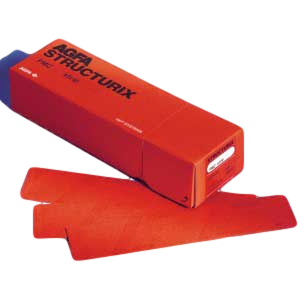

In the calibration of the instrument, one of the potentiometers is used to adjust an offset voltage, represented by α, and the other is used to set the constant β. The constants of this simple linear relation (2) are set by means of variable voltage dividers. The logarithmic amplifier gives a curve of response in the range of the OD values measured, which may be adjusted to the calibrated values of the density strip in each step by a linear relation. With high input impedance voltage followers, the two voltages from the two voltage dividers are carried to the analog-to-digital converter of the microcontroller. From its output are connected two variable voltage dividers. The reference voltage for the A/D conversion is obtained from a 2.5-volt precision voltage reference integrated circuit. With all the blocks working together, the next step is the calibration. The current source for the LED was constructed with a linear voltage regulator it is inexpensive, and due to the feedback and an internal voltage reference of 1.25 V, it keeps a constant current in the LED. The instrument takes power directly from four AA batteries, which produce 6 volts, 4.5 volts for the microcontroller and the other voltages required for the operational amplifiers and a negative voltage supply are obtained from a complementary metal-oxide-semiconductor (CMOS) switched-capacitor voltage converter (TL7660). This current adjusts the voltage range of the logarithmic amplifier to a maximum value in the case of the 4.00 OD suitable for A/D conversion and in the case of measurement without film, a minimum voltage that will be displayed like a 0.00 OD in the LCD. The logarithmic amplifier gives a voltage response proportional to the ratio of the current i 1 to the i 2, where i 1 is a current set to 500 μA with a 3-terminal adjustable current source. The calibration is achieved from two variable voltage dividers the values of these voltages are used like an offset to adjust the values of optical density displayed to the values of a calibration density strip tablet with the National Institute of Standards and Technology (NIST) traceability. A microcontroller performs the calculation of optical density and its display in a low-power consumption liquid crystal display (LCD). The acquisition and signal conditioning are achieved by implementing a circuit with the well-known integrated logarithmic amplifier LOG102. The instrument consists of a light source, viz., light-emitting diode (LED), a tiny aperture through which the light is directed and a light detector (photodiode) to measure the light intensity transmitted to the film. All the STRUCTURIX films benefit from an Agfa emulsion breakthrough that gives increased contrast and maximum detail. An overview of the system framework of the transmission densitometer is shown in Figure 1. In other fields, a similar technique has been used with good results as those presented here. Even other instruments have been constructed for this purpose, but the technology is old or they do not cover a wide range of optical density.
#AGFA STRUCTURIX PMC STRIPS ISO#
The master rolls of both trade marks are manufactured with identical quality assurance by AGFA in Mortsel, Belgium.īut there are also TESTIX D7M, C7 and E7 films for the Asian NDT market, which do NOT correspond to STRUCTURIX films and does not fit into the ISO 11699-1 classification scheme.The range of OD measured by the instrument is between 0.15 and 4.0 with an uncertainty of ☐.02 OD. Agfa’s inkjet printing solutions conquer five Pinnacle Product Awards. Agfa is proud to announce it received the essenscia Innovation Award 2022 for its groundbreaking Zirfon UTP 220 membrane technolog. Add to Cart Add to Compare (HI RENDOL 1) MAN. 502300(3455) Add to Cart Add to Compare DEVELOPER STARTER ADSTART. This roll fulfills all requirements of the film system class C4 of ISO 11699-1, when developed under standard conditions of the AGFA chemisty, which can be proven by certified PMC strips purchased from AGFA.įor the films itself I do not see any difference between STRUCTURIX D5 or D7 films and TESTIX D5 and D7 films beside the packaging is done in different parts of this world. Agfa’s Zirfon Green Hydrogen membrane awarded essenscia Innovation Award 2022. AGFA Structurix Processors AFP Mini NDT Processors Fuji X-Ray Film Processors Silver Recovery Systems Hydra Automatic Dosing System. That it is within our product surveillance of STRUCTURIX NDT film batches with AGFA. I am able to check the emulsion number of the master roll and can confirm,

In India for local distribution under the brand name TESTIX.

purchased a master roll from AGFA Mortsel and cut and packed it I did not know this before, but all is clear now. Thank you very much for the image you posted. Re: Difference between Agfa Structurix D7 and Agfa Testix D7


 0 kommentar(er)
0 kommentar(er)
